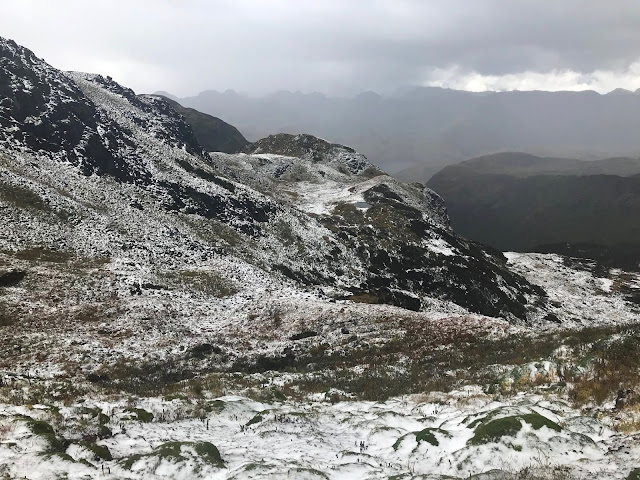I decided to stay in Ecuador on my own between December 14 and December 19. Originally I had planned on staying at a research station in the Amazonian lowlands for these five days but due to a landslide and subsequent road blockage that idea came off the table. Instead I elected to rent a car and do some birding/exploring within a few hours of Quito. I had a small list of target species to aim for - basically everything that I had dipped on up to this point!
I picked up my car during the afternoon of December 13, said my goodbyes to Laura, and motored back up the highway towards the Papallacta area. I had booked a room for two nights at a decent(ish) hotel in Papallacta for 15$ a night and I was excited for what the next day had in store!
Early the next morning I rolled out of bed, scarfed down breakfast at the hotel and headed a short distance up the road to Termas de Papallacta, a set of hot springs. At 8 AM the gate would open beyond the hot springs, allowing one to access an area of high-elevation forest in the Cayambe-Coca Ecological Reserve. I had four targets in mind for the day - Tawny-rumped Tyrannulet, Purple-backed Thornbill, Crescent-faced Antpitta and Agile Tit-Tyrant.
 |
| Superciliaried Hemispingus - Cayambe-Coca Ecological Reserve, Napo, Ecuador |
I birded the grounds of the resort while I waited for 8 AM to arrive. This proved to be a good decision since I encountered a Tawny-rumped Tyrannulet on the grounds, in the exact same area where my friends Tobias and Steph had seen one a week earlier. A great start!
 |
| Great Sapphirewing - Cayambe-Coca Ecological Reserve, Napo, Ecuador |
The morning was quite birdy and I enjoyed sifting through some mixed flocks. Superciliaried Hemispingus was a new one for my Ecuador list, as was Mountain Velvetbreast. I found a nice selection of hummingbirds, tanagers, wrens and flycatchers in several large mixed flocks. One of the flocks had a pair of Agile Tit-Tyrants as well!
 |
| Blue-backed Conebill - Cayambe-Coca Ecological Reserve, Napo, Ecuador |
My luck continued as I found a female Purple-backed Thornbill that was a little distant for good photos. A little while later I discovered a few more thornbills, including some aggressive males trying to defend their territories. They were also a little far for good photos, but at least the purplish colour to their backs is visible.
 |
| Purple-backed Thornbill - Cayambe-Coca Ecological Reserve, Napo, Ecuador |
This species of hummingbird is famous for having the shortest bill relative to body size out of any hummingbird species!
 |
| Purple-backed Thornbill - Cayambe-Coca Ecological Reserve, Napo, Ecuador |
I kept my ears open for Crescent-faced Antpittas throughout the morning, though none decided to vocalize. Oh well, three out of four ain't bad.
Feeling lucky after the successful morning, I backtracked slightly to the Papallacta Pass where I planned on birding the páramo around the radio antennas.
 |
| Cayambe-Coca Ecological Reserve, Napo, Ecuador |
Located around 4300 masl, the Papallacta Pass is the highest elevation that I've visited. While most birders commiserate about the terrible weather at the pass - horizontal rain and pea-soup fog - I have lucked out on my two previous visits. In no small part due to the (lack of) weather I have succeeded in observing Rufous-bellied Seedsnipe on both of those occasions.
 |
| Rufous-bellied Seedsnipes - Cayambe-Coca Ecological Reserve, Napo, Ecuador |
But the seedsnipes were not what I was after this time. I was hoping to finally stumble across Jameson's Snipe, a high-elevation species that is at home in bogs and meadows in the páramo. Of course as I drove up, the rain began, which turned into a slushy snow. Visibility was near nil as I waited out the snowstorm at the radio towers. After half an hour it let up and so I geared out and headed out. Another half an hour after that, the snow had completely stopped and the wind died down as I set off to explore the winter wonderland.
 |
| Cayambe-Coca Ecological Reserve, Napo, Ecuador |
 |
| Cayambe-Coca Ecological Reserve, Napo, Ecuador |
 |
| Cayambe-Coca Ecological Reserve, Napo, Ecuador |
They say that the best way to find a Jameson's Snipe up here is to tromp around in the spongy páramo bogs. And tromp I did. For three hours I explored prime looking habitat, praying to have a snipe flush out from beneath my feet. But three hours later, feeling exhausted, I had to admit defeat. I felt that not only did I give it the old college try, I gave it the PhD try, to no avail. Can't get them all!
Below are a few of the common páramo inhabitants that kept me company during my bog slog - a Plain-capped Ground-Tyrant and a Many-striped Canastero.
 |
| Plain-capped Ground-Tyrant - Cayambe-Coca Ecological Reserve, Napo, Ecuador |
 |
| Many-striped Canastero - Cayambe-Coca Ecological Reserve, Napo, Ecuador |
Despite dipping on the snipe the scenery was absolutely breathtaking. Without a doubt it was one of my favourite hikes from our time in Ecuador. No other people; just me and the mountains.


No comments:
Post a Comment